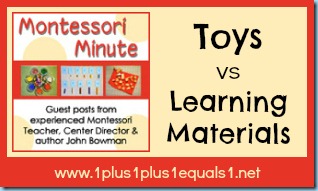 The media – toymaker industrial complex, borrowing a sixties phrase, depends on quickly turning our children into rabid consumers. Really, our way of life in developed countries depends on it; but that’s a story for a different blog.
The media – toymaker industrial complex, borrowing a sixties phrase, depends on quickly turning our children into rabid consumers. Really, our way of life in developed countries depends on it; but that’s a story for a different blog.
You take your child to the hot new movie and she just has to have the toys marketed along with it. Hey, Jackie has them next door! You don’t want to be Scrooge, and soon your house resembles a recycling depository for colorful plastics. Your child is already bugging you for the Next Big Thing.
Most disposable plastic toys are like sugary treats for your child’s brain. They provide a rush of excitement and interest, followed by a crash once the fever subsides. Then comes the next must-have toy and the cycle continues.
Dr. Maria Montessori said a few things about toys around 1940:
“The toy has become so important that people think it is a help to the intelligence. It is certainly better than nothing, but if we watch the child, we see he always wants new ones, he breaks them, he develops nervous and moral complaints. People who study the child superficially say that as he breaks the toy, he seems to find delight in taking everything apart and destroying everything. This is an artificially developed characteristic due to the circumstances which deprive the child of the right things.
He is not quiet with his toys…. for more than a few minutes. The real trouble is that children have no real interest in these things, because there is no reality in them. It is the misunderstanding on the part of the adult that has led to this life of lack of attention on the part of children; this useless life, a mockery of life instead of real life. The child cannot exercise the energies that nature has given him to perfect his individuality, they are wasted and worse than wasted.
The result is that the child cannot develop normally; and the longer he lives in this environment full of toys, the less capable he becomes of adapting himself to the real environment, and gradually his personality is completely deformed.
Maria Montessori, The Absorbent Mind
So, everyone who plays with toys is deformed? That’s a bit much, but consider Montessori’s passion for helping young children. The point she makes is true: young children want to take their place in the real world. Movie and toy fantasies will not keep them satisfied for long.
 In environments lacking any toys, children in Montessori schools are completely absorbed with dressing frames, juice squeezing, banana cutting, using tools, color tablets, sandpaper letters and numbers, geometric shapes, and materials like the Pink Tower. They all want to get their hands on these materials. This has been happening for over one hundred years. What’s going on?
In environments lacking any toys, children in Montessori schools are completely absorbed with dressing frames, juice squeezing, banana cutting, using tools, color tablets, sandpaper letters and numbers, geometric shapes, and materials like the Pink Tower. They all want to get their hands on these materials. This has been happening for over one hundred years. What’s going on?
These materials provide real food for their brains instead of a sugary rush of excitement. They help children in their work of creating independent, functional people, with strong brains and a positive sense of self. The good news for parents who cannot afford a Montessori or other good preschool: you can provide these materials and experiences right at home.
You can easily make almost an entire preschool full of learning materials for your child for about $300. If you supplement those with some original Montessori materials and other good commercial learning materials, displayed on low shelves rather than thrown in the toy box, your child can have many of the same experiences he would get in a Montessori school.
There is so much information out there now that any parent can begin doing early learning at home. Start with these blogs:
- 1+1+1=1
- Living Montessori Now
- Counting Coconuts
- Chasing Cheerios
- The Education of Ours
- Montessori Print Shop
- The Activity Mom
- Tot School
- Peaceful Parenting
- Discovery Days and Montessori Moments
Search these sites and their blog rolls for more excellent blogs and find your own favorites. Search Pinterest for Montessori, early learning, and preschool activities. My eBook, Montessori At Home! presents what you need to know in one place to save you hours of research; and gets you started quickly with a good understanding of where you’re going.
Montessori materials for home use
Before you say, “Too expensive“, total up what you will spend over three years on birthdays and holidays on disposable plastic toys. Be honest! I’ll wager that if you divert half or less of that to buying early learning materials, your budget won’t even notice it. The cost of Montessori materials has come down, and they last for years in schools, so you will be able to recover up to half their purchase price selling them later.
Montessori materials are not difficult to use. Most of them teach just by being handled. You can find videos and explanations by searching any material online. There are specifics to know about what materials will interest different ages of children and how to make and display materials in a Montessori way. All this information is available for the searching. You may find my and other books helpful here.
These materials are not toys and should be presented and treated differently than disposable toys that your child handles carelessly. How you present, display, and organize materials for your child’s use is important. It takes a different mindset than throwing toys in a toy box. Here are Montessori materials that I recommend in Montessori At Home! for home use:
Some good online Montessori suppliers:
An online search will find many more. There are many other Montessori materials that your child may find fascinating, take a look. A future post will offer a selection of other good commercial early learning materials – and there are many. We’ll also take a look at some of these Montessori materials in greater detail to try and find out what makes them so darn interesting.
Before you buy materials, check out the Montessori materials DIY and the free materials information at Living Montessori Now. Carisa offers loads of wonderful free materials right here on 1+1+1=1. Visit Montessori Print Shop for excellent free printables; and many more that are very inexpensive. This doesn’t have to be hard, it can be a whole lot of fun. The rewards of seeing your child engrossed in using a material you made are worth every minute.
Consider taking disposable plastic toys from center stage during your child’s formative early years. Substitute real world activities and good early learning materials that help your child learn real skills and build strong brain architecture. The benefits and rewards will be enormous.
John Bowman’s eBook, Montessori At Home!, has been downloaded by over 2000 parents, and many teachers, all over the world.
© 2012 John Bowman
My thanks to John for writing this extensive article for us here at 1+1+1=1! I invite you to ask him any questions you may have in the comments below and he can hopefully answer them for you. If you have an article you hope he will write for us in the future, please let us know in the comments also! Be sure to let him know if this article was helpful-we all love encouragement, right?
Did you miss earlier Montessori Minute Posts?
- Introducing Montessori Minute
- Where Do I Start?
- Sensory Activities
- Understanding Dr. Maria Montessori
- A Preschoolers Guide to Home Improvement
- The Three Part Lesson
- What is Montessori?
- Developing a Positive Self Image
- Concentration & Normalization
- Q & A with John Bowman {answers to questions left on the Sensory Activities post}
Check out our feature on Totally Tots, where Jodi is blogging her experiences while using Montessori At Home! with her young tots!




















